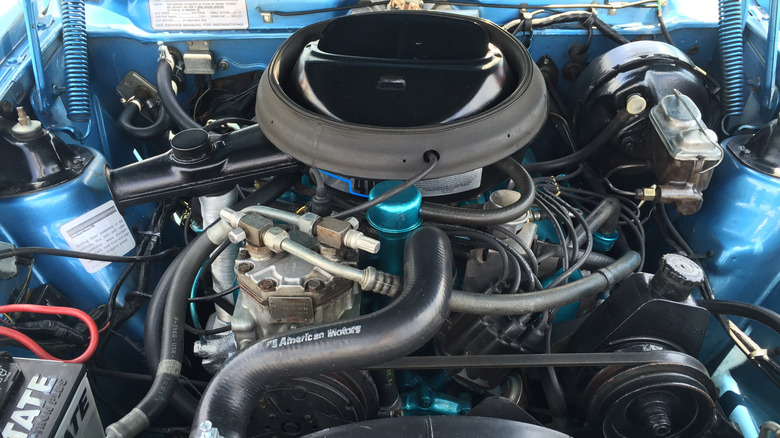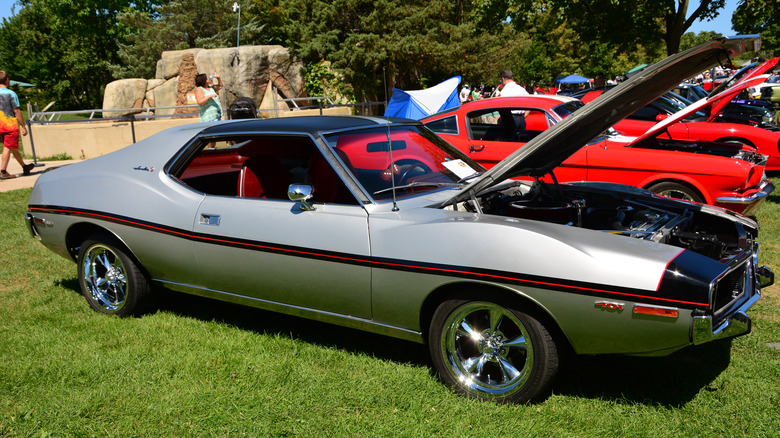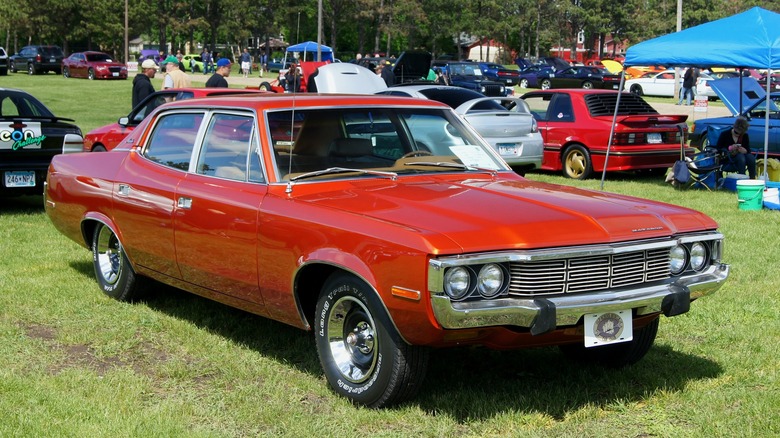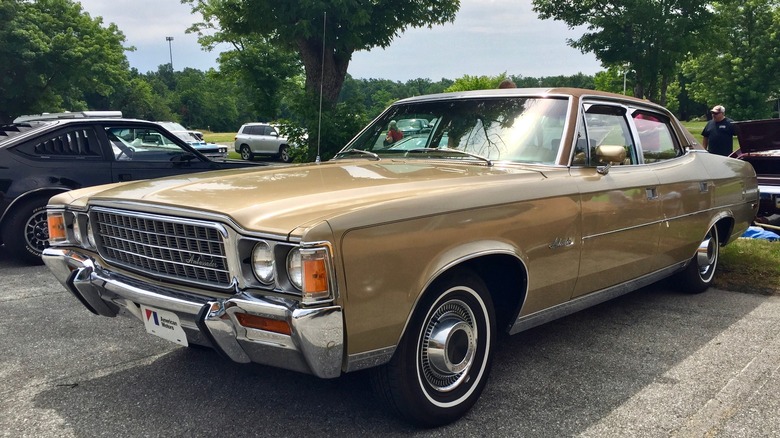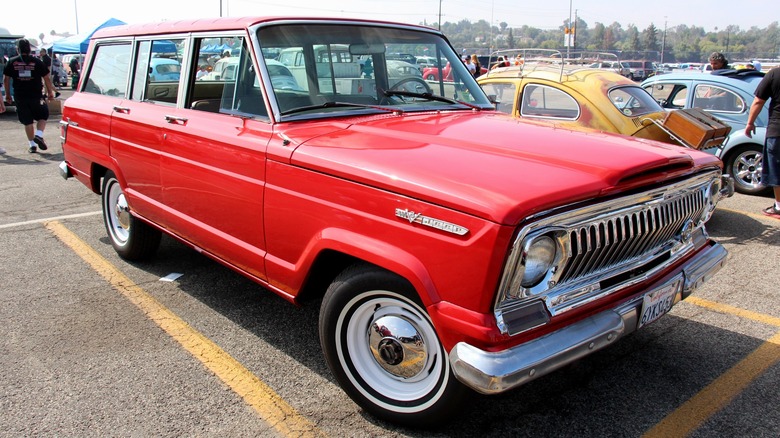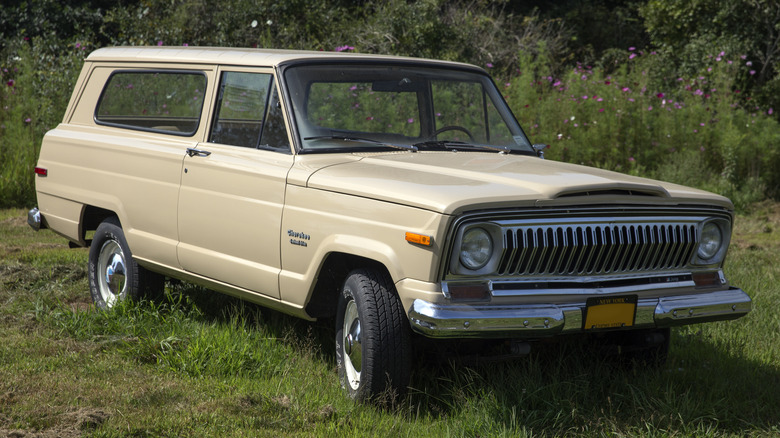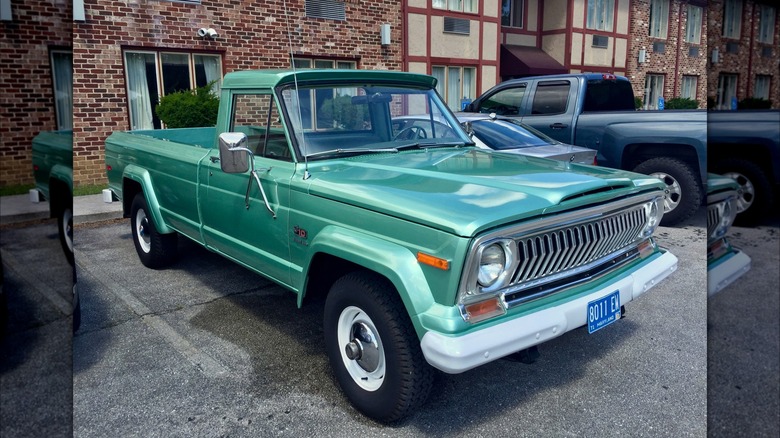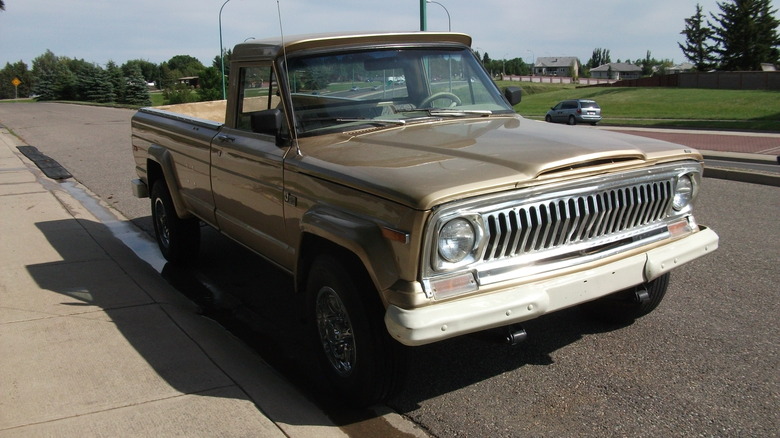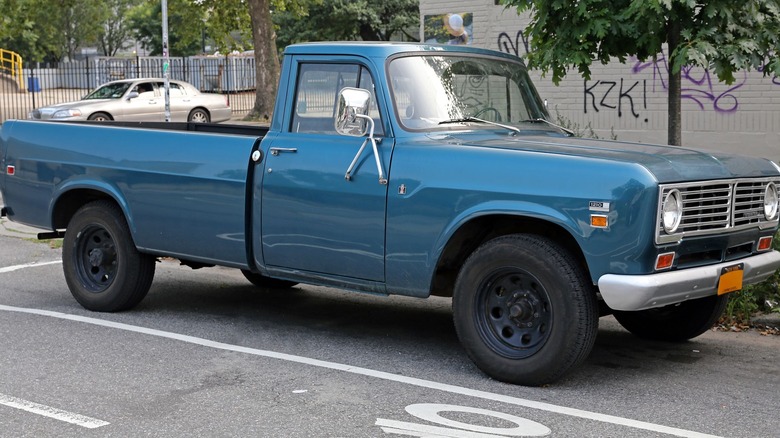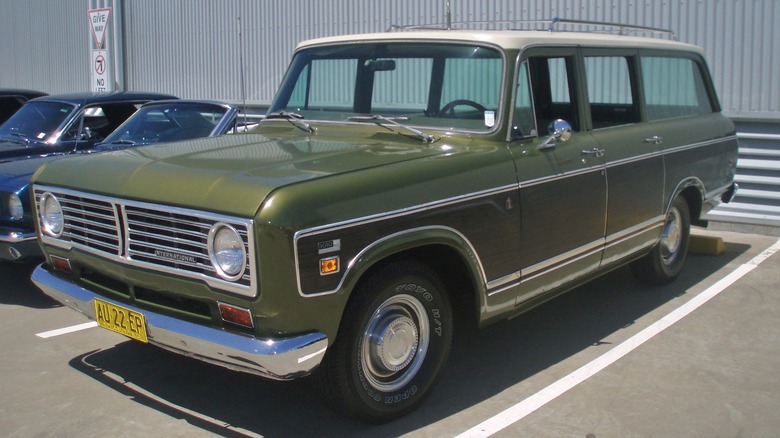Every Vehicle Powered By The AMC 401 V8 Engine
American Motors Corporation, better known as AMC, was one of the true underdogs of the American car industry in the 1960s and 1970s. The company, formed in 1954 after a merger between Nash-Kelvinator Corporation and Hudson Motor Car Company, competed with the Big Three on a much smaller budget by building lower-cost cars and filling niches that its Detroit rivals weren't as keen on exploring. However, while good-value cars like the Rambler — which makes a great project car, by the way — may have been AMC's bread and butter, the company wasn't all about budget-minded vehicles.
Cars like the AMC Javelin took the fight to GM, Ford, and Chrysler in the muscle car market, while its second-generation Ambassador one-upped its rivals in the luxury stakes. Then there's Jeep, which made some of the best Jeeps ever — like the Grand Wagoneer SJ and Cherokee Chief — under AMC's stewardship in the 1970s and 1980s.
All of these vehicles came with a selection of AMC V8s, with the largest of them all being the 401-CI AMC V8 that debuted in the early 1970s and used through most of the decade. The 401 doesn't quite have the same cachet as small- or big-block engines like the Chevrolet 350 V8, but it's developed quite a fanbase over the years. If you're interested in joining the AMC 401 fan club, here's a list of vehicles you'll want to look out for.
[Image by CZmarlin via Wikimedia Commons | Cropped and scaled | CC BY-SA 4.0]
AMC Javelin (1971 - 1974)
The AMC Javelin probably isn't the first that comes to mind when most of us think of muscle cars of the late 1960s and early 1970s. Still, over the years it's developed a reputation as one of the most underrated muscle cars ever, not least thanks to the engines it had under the hood.
AMC's second-generation Javelin, which debuted in 1971, played host to a wide gamut of engines, from a 232-CI inline-six that made a paltry 135 hp up to the 401-CI V8, which made 330 hp and 430 lb-ft of torque. Of course, the Javelin wasn't all engine — its allegedly Italian-derived styling and somewhat exaggerated wheel arches helped it stand out from the muscle and pony car crowd visually as well. In fact, it stood out even more with special editions like the Pierre Cardin Javelin that was available for a couple of years.
AMC offered the second-generation Javelin in three trim levels — the basic Javelin, the SST, and the AMX — the latter of which AMC merged into the Javelin line after existing as a standalone model during the late 1960s. The SST and AMX were the only models available with the 401 V8 as an option, with the latter also available with a Go package. This added a dual exhaust, an improved carburetor system, an uprated suspension, improved cooling, Rally-Pac instruments, E60-15 Goodyear Polyglas tires, 15x7-inch steel wheels, and some aesthetic touches like a hood stripe. The AMC Javelin was available with the 401 V8 until 1974, with AMC discontinuing a year later.
AMC Matador (1971 - 1976)
AMC's mid-size Matador was one of the three AMC cars to receive the 401 V8 for the 1971 model year alongside the Javelin and Ambassador. AMC pitched the 1971 Matador as a family-oriented, somewhat luxury car and offered it in three versions — it was available as a two-door hardtop, a four-door sedan, and a four-door wagon. All of which had enough room for six or more with the wagon's optional third seat.
The luxury angle was perhaps a bit of a stretch by today's standards, but features such as carpets all around, a padded instrument panel, and locking glove boxes perhaps held a bit more weight back in 1971. Optional luxury features for the 1971 Matador included individual reclining seats, power steering, tinted glass, and air-conditioning. However, the Matador wasn't all about comfort and style, and owners who opted for the 330 hp, 430 lb-ft 401 V8 also got a dual exhaust system as standard and could even spec a limited-slip differential.
There was another option, however: the Machine Go package. This $373 — just under $2,900 in 2024 — package was available for the 360 and 401ci V8s and consisted of handling improvements, E60-15 Goodyear Polyglas tires, a spare tire, 15x7-inch wheels, and front disc brakes, turning the underrated AMC Matador into a serious street machine. Machine Go buyers with the 360 CI V8 also received dual exhausts and a four-barrel carb. AMC quickly dropped the Machine Go option but kept the 401 until 1974. Police Matadors remained available with the 401 until 1976.
[Image by Greg Gjerdingen via Wikimedia Commons | Cropped and scaled | CC BY 2.0]
AMC Ambassador (1971 - 1974)
The AMC Ambassador was the company's luxury play, a full-sized car with amenities such as air-conditioning and an automatic transmission as standard, which AMC claimed was unique amongst American cars at the time. That may seem quaint now, but things were different in 1971– Chrysler's luxury Imperial, for example, only offered air-conditioning as an option, so AMC certainly had a point there.
Otherwise, the Ambassador was broadly similar to the Matador in mechanical terms. Engines including the reliable 150 hp 258 inline-six, two- and four-barrel versions of the AMC 360 V8 (making 245 and 285 hp, respectively), and the big daddy 401 V8 with its full 330 hp and 430 lb-ft of torque — although the latter wasn't available on the four-door DPL Ambassador, with AMC limiting the 401 to the SST and Brougham trims for the sedan, wagon, and two-door hardtop Ambassadors. Three-speed automatic transmissions were standard across all engine options and trim levels, although owners could choose between column or console shifters on all but the base inline-six.
Despite being a luxury car, AMC couldn't resist offering some sporty options to owners. The Matador's dual exhaust system was also available and was once again standard with the 401. Perhaps more interestingly, 401 equipped Ambassador owners who opted for a console shifter could also install a 3.54 rear gear in their car, a big leap from the 2.87 it came with by default. The 401 continued in the Ambassador until 1974, after which AMC discontinued the car.
[Image by CZmarlin via Wikimedia Commons | Cropped and scaled | CC BY-SA 1.0]
Jeep Wagoneer (1974 - 1978)
AMC may have dropped most of its passenger cars in the mid-1970s, but that didn't mean the death of the 401 V8. Having taken over Jeep in 1970, AMC began the process of transplanting its engines into the brand's vehicles. The Wagoneer was the first Jeep to get an AMC powerplant, with the 258 cubic inch inline-six debuting in the engine bay in 1971, followed by AMC's 304 and 360 V8s soon after.
The 258 cubic inch inline six only lasted a few years, and AMC stopped offering it for the Wagoneer in 1974. Starting that year, the 175 hp 360-CI V8 with a two-barrel carburetor was the base engine option, befitting AMC's plans to push the Wagoneer into a more premium market segment. Of course, AMC didn't stop there — it also introduced the 401-CI V8 with four-barrel carb to the Wagoneer the same year, which made a much healthier 215 net hp and 320 lb-ft of torque.
AMC didn't tinker much with the Jeep Wagoneer's engine options over the next few years. However, things changed significantly in 1979, when prospective owners of that year's Jeep Wagoneer had to settle for a two-barrel 360-CI V8. To add insult to injury, the 1979 version of the 360 was slightly down on power and only made 160 net hp. Despite that, AMC didn't look back, and the 401 V8 never returned to the Wagoneer's engine bay. The Wagoneer itself lives on, however, with an electric Jeep Wagoneer S debuting in 2024.
[Image by Sicnag via Wikimedia Commons | Cropped and scaled | target="_blank">CC BY 2.0]
Jeep Cherokee (1974 - 1978)
AMC's decision to make the Wagoneer a more premium vehicle in 1974 meant that there was a gap for a more affordable, youth-oriented full-size vehicle. Enter the Jeep Cherokee, which debuted in 1974 as a more off-road-focused — and cheaper — version of the Wagoneer, but one that didn't give up much, if anything, in the engine department.
The first-generation Jeep Cherokee wasn't that different from the Wagoneer, with the same SJ body, just in a two-door form. The engines weren't all that different, either. The base engine was the tame 110 hp 258-CI inline-six that AMC had introduced to the Wagoneer earlier in the decade, but AMC also made the Wagoneer's larger eight-cylinders available in the Cherokee. Buyers could opt for the two- or four-barrel 360-CI V8s or go all out and get the AMC 401 V8, which made the same 215 hp as it did in the Cherokee's bigger brother.
Reflecting its off-road aspirations, the Cherokee came with a two-speed Dana transfer case as standard, along with bucket seats — the more family-minded Wagoneer sported a bench seat by default. Buyers could also opt for steel-belted radials and a snow boss, amongst other options, although the lower pricing meant that the Cherokee only had a standard four-wheel-drive system, with the Wagoneer's automatic Quadra-Trac system an extra-cost option. The 401 V8 stayed as the Cherokee's top-end engine option until 1978, after which AMC pared engine options down to the 258 inline-six and two-barrel 360 V8.
[Image by Mr.choppers via Wikimedia Commons | Cropped and scaled | CC BY-SA 3.0]
Jeep J-10 (1974 - 1978)
Jeep's J-series pickups started life in the early 1960s as the Gladiator pickups, available in various configurations to suit buyers' needs — including dual-rear-wheel models and ones with gross vehicle weight ratings of an impressive 8,000 pounds or thereabouts. These debuted with Jeep's Tornado six-cylinder engine in the engine bay, which put out 140 hp and 210 lb-ft of torque.
AMC's takeover of Jeep triggered a name change, and the Jeep pickups dropped the Gladiator name in 1971, with the shorter 119 inch wheelbase pickup renamed the J-10 that year. As with the other Jeeps, AMC also began offering its engines in the J-10, with the same 110 hp 258 cubic inch six-cylinder as the base engine. However, AMC also gave buyers the option of a higher-compression 258, which made a much more impressive 150 hp. AMC also offered 304 and 360 V8s, although the 304 only lasted until 1973.
Starting in 1974, the AMC 401 V8 entered the picture, relegating the 360-CI V8 — which was available in two- and four-barrel configurations — to being the entry-level eight-cylinder option for prospective J-10 owners. The 401 made 215 hp and 320 lb-ft of torque in the J-10 and was available until 1978, sharing space on the options list with the evocatively-named Honcho and Golden Eagle trim packages for a couple of years. By 1979, AMC had reduced the J-10's engine options to the same 258 inline-six and two-barrel 360 V8 it offered in other full-size Jeeps.
[Image by CZmarlin via Wikimedia Commons | Cropped and scaled | CC BY-SA 4.0]
Jeep J-20 (1974 - 1976)
The J-10 was a slightly shorter version of the Gladiator truck it replaced, but not by much — its wheelbase was 118.7 inches compared to the 120 inches of the old J-200 Gladiator. The J-20 went the opposite route, with AMC opting for a 131-inch wheelbase, a significant extension over the J-300's 126 inches. The J-20 was a more heavy-duty take on the same Jeep pickup concept as the J-10, reflected in the fact that AMC's two-barrel 360 cubic inch V8 came as standard on the longer-wheelbase pickup.
Engines were otherwise identical to the J-10, with the four-barrel 360 V8 and four-barrel 401 V8 available as options starting in 1974 and available through 1978, after which the same 258 six-cylinder and two-barrel 360 V8 were the only options. Unlike the J-10, however, the J-20 didn't have any fancy trim packages, with both the Honcho and Golden Eagle packages only available on the 119-inch J-10.
What the J-20 gave up in cool extras, it made up for in sheer utility. Owners could opt for 7,600 and 8,400 gross vehicle weight-rated versions of the J-20, and its extra capacity opened up a wider variety of camper and trailer options. Fifth-wheel RVs and cab-over campers, for example, were solely the domain of the J-20, at least according to Jeep's recommendations. The J-20 also had different tires available, with synthetic rubber Goodyear tires as standard and extra-grip wide-lug tires available for cold weather use.
[Image by dave_7 via Wikimedia Commons | Cropped and scaled | CC BY 2.0]
International Harvester Light Line pickups (1973 - 1974)
From one somewhat forgotten brand to another — International Harvester (IH) may not be a household name now, but it was once a major name in the U.S. agricultural industry, producing farm equipment such as tractors and plows and several generations of pickup trucks, the final of which featured AMC's 401 V8 for a brief time. International Harvester's Light Line — or D-Series — pickups debuted in 1969 as a successor to the C-Series pickups, ditching the old pickups' rounded styling for a cleaner, flatter, and much more modern look and updating the powertrains to suit.
The D-Series pickups debuted with a selection of IH V8 engines, with a 155 bhp, 227 lb-ft 266 cubic inch V8 the standard engine in models like the 1200 D. IH also offered 304, 345, and 392 cubic inch V8 engines, while a 232 AMC six-cylinder engine was also available on four-wheel-drive models. IH eventually added another AMC engine to its options list in March 1973 with the introduction of the AMC 401 V8, which was also briefly available the following year.
Unfortunately, International Harvester's sales were in freefall by this point, with rising inflation and the oil embargo of 1973 not helping matters. The company's truck sales dipped 12% during the 1975 recession, which proved to be the final nail in the coffin for International Harvester: it exited the truck and SUV market and shifted its focus to its medium and heavy-duty trucks instead.
[Image by Mr.choppers via Wikimedia Commons | Cropped and scaled | CC BY-SA 3.0]
International Harvester Travelall (1973 - 1974)
The D-Series pickups weren't the only International Harvester vehicles to use the AMC 401 V8, however. The company also used the engine for a few years in its proto-SUV Travelall and Travelette vehicles. The fourth-generation Travelall combined a station wagon body with a truck frame, with IH marketing it as a do-it-all machine capable of carrying a total of 11,000 pounds and available in several seating configurations.
Like the Light Line pickups, the largest in-house engine available for the Travelall was the 392-CI V8. However, AMC's 401 V8 also made a short cameo appearance in the Travelall and Travelette engine bays in 1973 and 1974. However, unlike the Jeep and AMC implementations, International Harvester opted for a two-barrel carburetor on the Travelall — and D-Series — 401, which dropped power to 210 net hp.
As to why IH only used the 401 for a brief period, the consensus amongst enthusiasts is that IH simply didn't have enough 392 V8s to go around and needed a large-displacement engine to go in its light vehicles. The fact that IH switched back to the 392-CI V8 in 1975 lends some credence to this story, although there's likely no way of knowing for sure.
International discontinued the Travelall and Travelette in the mid-1970s, although it didn't abandon the nascent SUV market entirely. It also introduced the Scout II, which survived into the 1980s and gained enough goodwill for Volkswagen to resurrect it nearly 45 years on.
[Image by sv1ambo via Wikimedia Commons | Cropped and scaled | CC BY 2.0]
